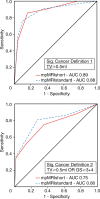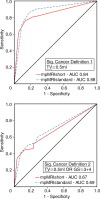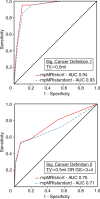Detection of Clinically Significant Prostate Cancer: Short Dual-Pulse Sequence versus Standard Multiparametric MR Imaging-A Multireader Study
- PMID: 28346073
- PMCID: PMC5584651
- DOI: 10.1148/radiol.2017162020
Detection of Clinically Significant Prostate Cancer: Short Dual-Pulse Sequence versus Standard Multiparametric MR Imaging-A Multireader Study
Abstract
Purpose To compare the diagnostic performance of a short dual-pulse sequence magnetic resonance (MR) imaging protocol versus a standard six-pulse sequence multiparametric MR imaging protocol for detection of clinically significant prostate cancer. Materials and Methods This HIPAA-compliant study was approved by the regional ethics committee. Between July 2013 and March 2015, 63 patients from a prospectively accrued study population who underwent MR imaging of the prostate including transverse T1-weighted; transverse, coronal, and sagittal T2-weighted; diffusion-weighted; and dynamic contrast material-enhanced MR imaging with a 3-T imager at a single institution were included in this retrospective study. The short MR imaging protocol image set consisted of transverse T2-weighted and diffusion-weighted images only. The standard MR imaging protocol image set contained images from all six pulse sequences. Three expert readers from different institutions assessed the likelihood of prostate cancer on a five-point scale. Diagnostic performance on a quadrant basis was assessed by using areas under the receiver operating characteristic curves, and differences were evaluated by using 83.8% confidence intervals. Intra- and interreader agreement was assessed by using the intraclass correlation coefficient. Transperineal template saturation biopsy served as the standard of reference. Results At histopathologic evaluation, 84 of 252 (33%) quadrants were positive for cancer in 38 of 63 (60%) men. There was no significant difference in detection of tumors larger than or equal to 0.5 mL for any of the readers of the short MR imaging protocol, with areas under the curve in the range of 0.74-0.81 (83.8% confidence interval [CI]: 0.64, 0.89), and for readers of the standard MR imaging protocol, areas under the curve were 0.71-0.77 (83.8% CI: 0.62, 0.86). Ranges for sensitivity were 0.76-0.95 (95% CI: 0.53, 0.99) and 0.76-0.86 (95% CI: 0.53, 0.97) and those for specificity were 0.84-0.90 (95% CI: 0.79, 0.94) and 0.82-0.90 (95% CI: 0.77, 0.94) for the short and standard MR protocols, respectively. Ranges for interreader agreement were 0.48-0.60 (83.8% CI: 0.41, 0.66) and 0.49-0.63 (83.8% CI: 0.42, 0.68) for the short and standard MR imaging protocols. Conclusion For the detection of clinically significant prostate cancer, no difference was found in the diagnostic performance of the short MR imaging protocol consisting of only transverse T2-weighted and diffusion-weighted imaging pulse sequences compared with that of a standard multiparametric MR imaging protocol. © RSNA, 2017 Online supplemental material is available for this article.
Figures
















Similar articles
-
Diagnostic accuracy of biparametric vs multiparametric MRI in clinically significant prostate cancer: Comparison between readers with different experience.Eur J Radiol. 2018 Apr;101:17-23. doi: 10.1016/j.ejrad.2018.01.028. Epub 2018 Feb 1. Eur J Radiol. 2018. PMID: 29571792
-
Abbreviated Biparametric Prostate MR Imaging in Men with Elevated Prostate-specific Antigen.Radiology. 2017 Nov;285(2):493-505. doi: 10.1148/radiol.2017170129. Epub 2017 Jul 20. Radiology. 2017. PMID: 28727544
-
Multiparametric prostate MR imaging with T2-weighted, diffusion-weighted, and dynamic contrast-enhanced sequences: are all pulse sequences necessary to detect locally recurrent prostate cancer after radiation therapy?Radiology. 2013 Aug;268(2):440-50. doi: 10.1148/radiol.13122149. Epub 2013 Mar 12. Radiology. 2013. PMID: 23481164 Free PMC article.
-
Multiparametric MRI in detection and staging of prostate cancer.Dan Med J. 2017 Feb;64(2):B5327. Dan Med J. 2017. PMID: 28157066 Review.
-
Multiparametric magnetic resonance imaging: Current role in prostate cancer management.Int J Urol. 2016 Jul;23(7):550-7. doi: 10.1111/iju.13119. Epub 2016 May 17. Int J Urol. 2016. PMID: 27184019 Review.
Cited by
-
Current Status of Biparametric MRI in Prostate Cancer Diagnosis: Literature Analysis.Life (Basel). 2022 May 28;12(6):804. doi: 10.3390/life12060804. Life (Basel). 2022. PMID: 35743835 Free PMC article. Review.
-
Comparison between multiparametric MRI with and without post - contrast sequences for clinically significant prostate cancer detection.Int Braz J Urol. 2018 Nov-Dec;44(6):1129-1138. doi: 10.1590/S1677-5538.IBJU.2018.0102. Int Braz J Urol. 2018. PMID: 30325611 Free PMC article.
-
Prospectively Accelerated T2-Weighted Imaging of the Prostate by Combining Compressed SENSE and Deep Learning in Patients with Histologically Proven Prostate Cancer.Cancers (Basel). 2022 Nov 22;14(23):5741. doi: 10.3390/cancers14235741. Cancers (Basel). 2022. PMID: 36497223 Free PMC article.
-
Landmarks in the evolution of prostate biopsy.Nat Rev Urol. 2023 Apr;20(4):241-258. doi: 10.1038/s41585-022-00684-0. Epub 2023 Jan 18. Nat Rev Urol. 2023. PMID: 36653670 Review.
-
Prostate volume analysis in image registration for prostate cancer care: a verification study.Phys Eng Sci Med. 2023 Dec;46(4):1791-1802. doi: 10.1007/s13246-023-01342-4. Epub 2023 Oct 11. Phys Eng Sci Med. 2023. PMID: 37819450 Free PMC article.
References
-
- Blomqvist L, Carlsson S, Gjertsson P, et al. . Limited evidence for the use of imaging to detect prostate cancer: a systematic review. Eur J Radiol 2014;83(9):1601–1606. - PubMed
-
- Scheenen TW, Rosenkrantz AB, Haider MA, Fütterer JJ. Multiparametric magnetic resonance imaging in prostate cancer management: current status and future perspectives. Invest Radiol 2015;50(9):594–600. - PubMed
-
- Rosenkrantz AB, Shanbhogue AK, Wang A, Kong MX, Babb JS, Taneja SS. Length of capsular contact for diagnosing extraprostatic extension on prostate MRI: Assessment at an optimal threshold. J Magn Reson Imaging 2016;43(4):990–997. - PubMed
Publication types
MeSH terms
Grants and funding
LinkOut - more resources
Full Text Sources
Other Literature Sources
Medical

